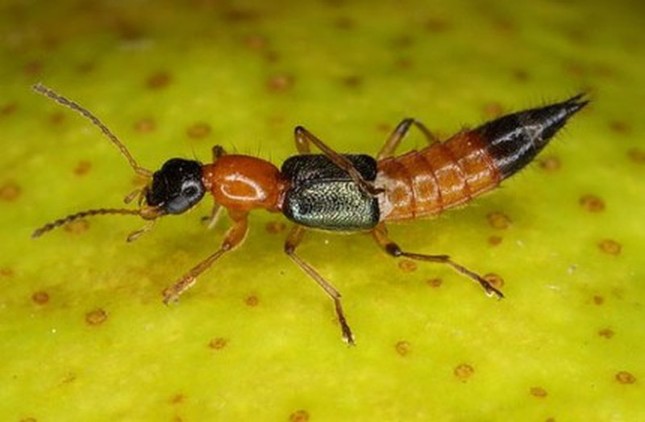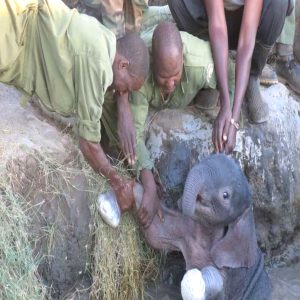This ant species is present in Vietnam, flying and running very fast.
Although not actively attacking, stinging or biting people, if bitten, the wound on the skin is quite dangerous.
Three-chambered ant
The three-chambered ant is a common folk name, the scientific name is Paederus fuscipes CURTIS,
1826, belonging to the family Staphilinidae (the Penguin family), the order Coleoptera.
This insect has a slender body, as long as a grain of rice (1 - 1.2 cm long, 2 - 3 mm wide), has two colors red and black,
looks like an ant.
Therefore, people often call it with many different names such as wild ants, needle ants, cross ants, rice ants, double chin,
caged ants,
curved ants...
This type of ant does not actively attack, sting or bite people, but because the body fluids of the bugs contain pederin,
when they crawl on people, when they are caught, they have a self-defense reflex to bite or secrete pederin.
The three-compartment ant is a dangerous insect that contains Pederin toxin (C24H43O9N) in the body,
which is 12-15 times more toxic than cobra venom.
Although the venom of the three-cavity ant is very toxic, due to the small amount of contact and only on the skin,
it is not enough to cause death like snake venom. This substance mainly causes skin burns, easily confused with lesions in shingles,
shingles.

When being bitten by three-cavity ants, if the injury is mild, there will be a local burning sensation,
severe can cause fever, swollen lymph nodes nearby, and infection.
Usually, the patient will have a tingling sensation immediately after contact with the poison of the ants,
but it takes 6-8 hours to feel the burning sensation and after about 12-24 hours, there will be blisters,
after 3 days will scabs and after 5-7 days will heal but still have bruises.
Where do three-cavity ants usually live?
In the past, three-chambered ants often concentrated on living in fields, especially around stubble, lawns,
gardens, landfills, and construction sites... However, in recent years, the speed has increased.
Rapid urbanization along with the widespread use of pesticides by farmers have made the ecosystem unbalanced.
The natural enemies are almost destroyed, so that the three-chambered ants can fly and appear in other places such as houses,
dormitories, apartment buildings, schools, dormitories, garbage dumps...
During the rainy seasons,
these ants will move to drier places to live.
After rainy days, flooding the fields or ponds, at night, the three-chambered ants will follow the lights to fly into the house.
They can perch on the human body, on clothing, blankets, bedding or other household items.

Three-compartment ants are insects whose colors are alternating black and yellow-orange cavities,
they have a slender and long body like a grain of rice (about 0.7-1 cm in length, about 2- 5 mm in width).
The three-cavity ant has three pairs of spiked legs, the abdomen is divided into segments, and the shiny pointed tail.
A black head, above the head there are 2 antennae divided and extended forward.
In addition, they also have 2 pairs of wings in which a pair of long thin transparent wings are neatly folded and hidden just below the short hard wings.
When they fly, the wings are spread, moreover, their wings are very strong, so the three-cavity ants often fly very fast.
The three-chambered ants often thrive in the rainy season and when the weather is high humidity.
Their main food is insects that damage farmers' crops. When the rice field appears brown planthoppers or leaf rollers,
they come and burrow into the worm's nest to eat each one. It is for this reason that in the past,
the three-chambered ant was considered a natural enemy and a good friend of farmers.

Turn on the yellow light to repel ants
When getting ants on the skin, do not kill the ants with your hands,
so just blow the ants away or cover them lightly with a soft object,
use a piece of paper to make the ants crawl automatically,
and then handle the kill in as many ways as possible (great).
do not come into direct contact with ants).
The places where ants are likely to fly in from the outside,
to limit and prevent ants from entering the house,
you can use a light trap (white or purple light) at the window or door in the evening.
Underneath put a basin of water or catch it with a curtain.
Ants attracted by light will focus on the place where the light trap is located.
The setting of traps and time depends on the family, but must ensure safety and not affect daily life.
It is best to use insect catching lights on the market and place them in places where black ants are suspected.
When installing lights, it should be replaced with filament lamps with red and yellow light.
Before going to bed, shake off the blankets, mats, and drapes so that the three compartments do not fly in.
When using a towel or clothing, it should be shaken before use to see if there are ants.
When you see ants, absolutely do not kill ants by hand, but use paper, rags, towels... to kill and clean up ants.








